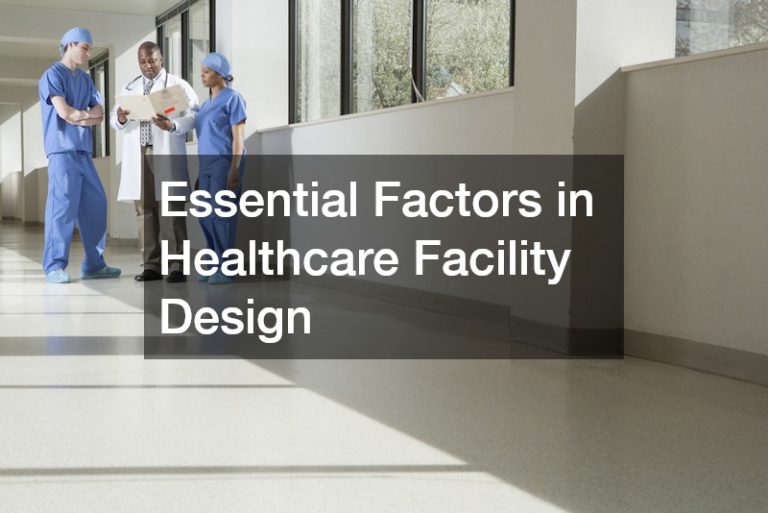A well-designed healthcare facility can enhance patient outcomes, improve staff efficiency, and contribute to the overall well-being of everyone who uses the space. Healthcare design professionals with jobs at Thomas and Hutton understand that there are many essential factors to consider in healthcare facility design. Let’s review them below!
Patient-Centered Design
Comfort and Healing Environment: The primary goal of any healthcare facility is to promote healing and well-being. This starts with creating a comfortable environment that reduces stress and anxiety for patients. Natural lighting, calming colors, and access to nature can significantly impact a patient’s recovery process. Incorporating elements such as comfortable seating, private rooms, and quiet spaces can also contribute to a healing environment.
Accessibility and Inclusivity: Healthcare facilities must be accessible to all patients, including those with disabilities. This involves ensuring that entrances, restrooms, and patient rooms are wheelchair accessible and that signage is clear and easy to read. Inclusive design also means considering the needs of different cultural groups and providing spaces that respect and accommodate diverse practices and preferences.
Functional and Efficient Layout
Workflow Optimization: An efficient layout is crucial for the smooth operation of a healthcare facility. Healthcare design professionals with jobs at Thomas and Hutton understand that this includes strategically placing departments and services to minimize travel distances for both staff and patients. For example, locating diagnostic services close to treatment areas can reduce the time and effort required to move patients around the facility. Additionally, ensuring that critical supplies and equipment are readily accessible can enhance staff efficiency and reduce response times.
Flexibility and Adaptability: Healthcare needs are constantly evolving, and facilities must be designed with flexibility in mind. This means creating spaces that can easily be reconfigured to accommodate new technologies, changes in patient demographics, or shifts in service delivery models. Modular design elements, movable walls, and multi-purpose rooms can help ensure that a facility remains functional and relevant over time.
Safety and Hygiene
Infection Control: Infection control is a top priority in healthcare facility design. This involves using materials and finishes that are easy to clean and disinfect, as well as designing spaces to minimize the risk of contamination. Features such as hand hygiene stations, negative pressure rooms, and antimicrobial surfaces can help reduce the spread of infections. Proper ventilation systems are also essential to maintain air quality and prevent the transmission of airborne pathogens.
Safety and Security: Ensuring the safety and security of patients, staff, and visitors is another critical aspect of healthcare facility design. This includes implementing security measures such as surveillance cameras, controlled access points, and alarm systems. Additionally, designing spaces to reduce the risk of accidents and injuries—such as slip-resistant flooring, adequate lighting, and clearly marked emergency exits—is essential for creating a safe environment.
Technological Integration
Advanced Technology: The integration of advanced technology is vital in modern healthcare facilities. This includes everything from electronic health records (EHR) systems and telemedicine capabilities to state-of-the-art diagnostic and treatment equipment. Ensuring that the facility’s infrastructure can support these technologies—such as providing sufficient power supplies, data cabling, and wireless connectivity—is crucial for effective operation.
Future-Proofing: As technology continues to advance, it is important to design facilities that can accommodate future innovations. This means planning for potential upgrades and expansions, such as installing modular cabling systems and leaving space for additional equipment. Future-proofing also involves staying informed about emerging trends and developments in healthcare technology to ensure that the facility remains at the cutting edge.
Sustainability
Energy Efficiency: Sustainable design practices are increasingly important in healthcare facilities. Energy-efficient systems—such as LED lighting, energy-efficient HVAC systems, and renewable energy sources—can help reduce operational costs and minimize the facility’s environmental impact. Additionally, designing buildings to maximize natural light and ventilation can further enhance energy efficiency.
Sustainable Materials: Using sustainable materials and construction practices can also contribute to a facility’s overall sustainability. This includes selecting materials with low environmental impact, such as recycled or locally sourced products, and using construction methods that minimize waste. Implementing green building standards, such as LEED certification, can help ensure that the facility meets high environmental performance standards.

Community and Staff Considerations
Staff Well-Being: The design of a healthcare facility should also prioritize the well-being of the staff. This includes providing comfortable and functional workspaces, break areas, and amenities such as fitness facilities and quiet rooms. Ensuring that staff have access to natural light and views of nature can also improve their overall job satisfaction and productivity.
Community Integration: Finally, healthcare facilities should be designed with the broader community in mind. This involves creating spaces that are welcoming and accessible to all members of the community, as well as providing amenities such as community meeting rooms and wellness programs. Engaging with the community during the design process can help ensure that the facility meets the needs and expectations of those it serves.




